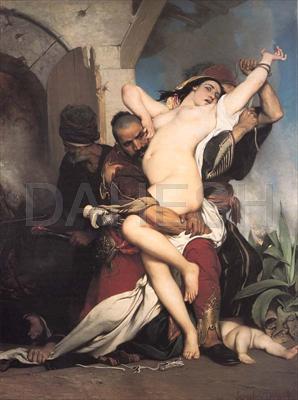Jaroslav Čermák (Czech, 1830–1878)
The Abduction of a Herzegovinian Woman, 1861
Oil on canvas, 98 1/2 x 75 in.
Signed lower right: Jaroslav Čermák
2000.19

This painting’s title at the 1861 Paris Salon, Abduction by Bashi-bazouks in a Christian Village in Herzegovina, (Razzia de bachi-bouzouchs dans un village chrétien de l’Herzégovine (Turquie) [sic]) immediately situated the image within a volatile ethnic and religious discourse. Disturbing and extremely evocative, it depicts a white, nude Christian woman being abducted from her village by the Ottoman mercenaries who have killed her husband and baby. Apart from the Salon title, the crucifix on a broken chain lying in the foreground leaves little question about the religious convictions of the woman. This terrifying scene reflected actual turmoil in the war-torn regions of central Europe, where Čermák witnessed Turkish troops attacking villages. The Parisian critic Théophile Gautier surmised that rape was not the woman’s immediate fate, as the scene would at first suggest, but rather that she was to be sold into a harem. The traffic in white slaves, although officially prohibited by the Ottoman sultan in 1854–55, continued for many years; its eradication became the objective of many outraged Christian missionaries. A wrenching image of the clash between East and West, this picture unfortunately continues to have chilling contemporary reverberations.
The form Čermák gave to this political statement was inspired by famous depictions of mythological abduction scenes, including Giambologna’s The Rape of the Sabine Women (1583, Loggia dei Lanzi, Florence) and Gian Lorenzo Bernini’s The Rape of Proserpina (ca. 1622, Rome, Galleria Borghese). Čermák received a medal for this painting at the 1861 Salon and, after being widely exhibited throughout Europe, it was purchased by Theodore A. Havemeyer, an important New York collector of the Gilded Age.


